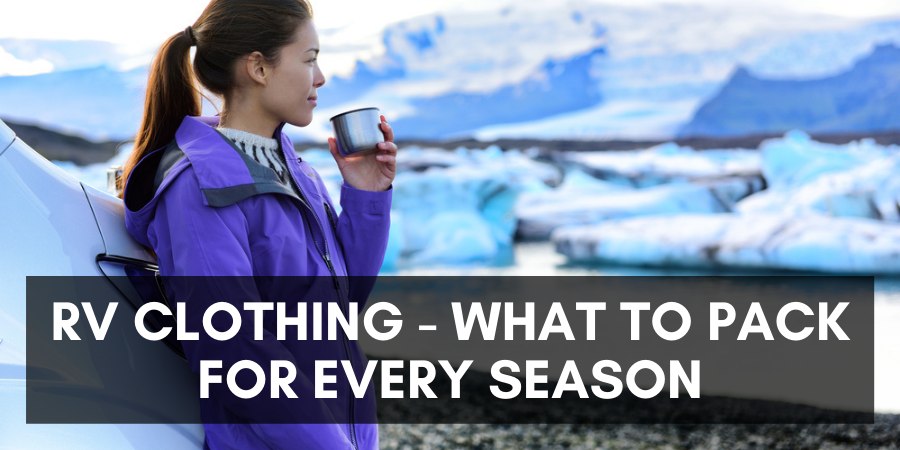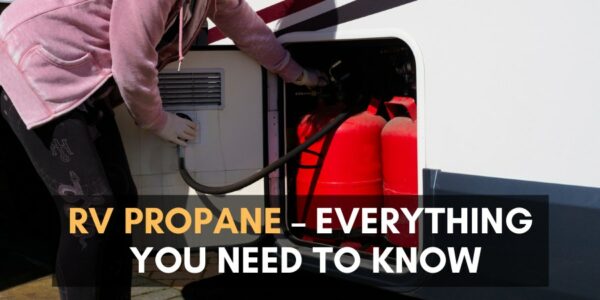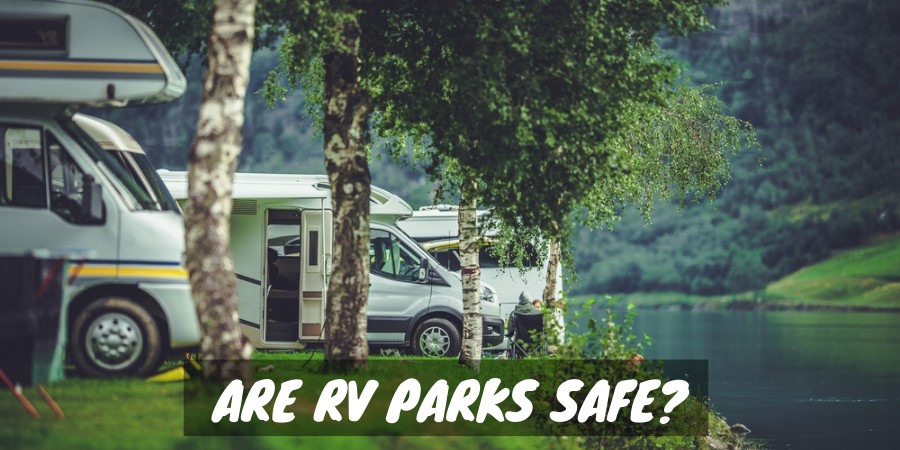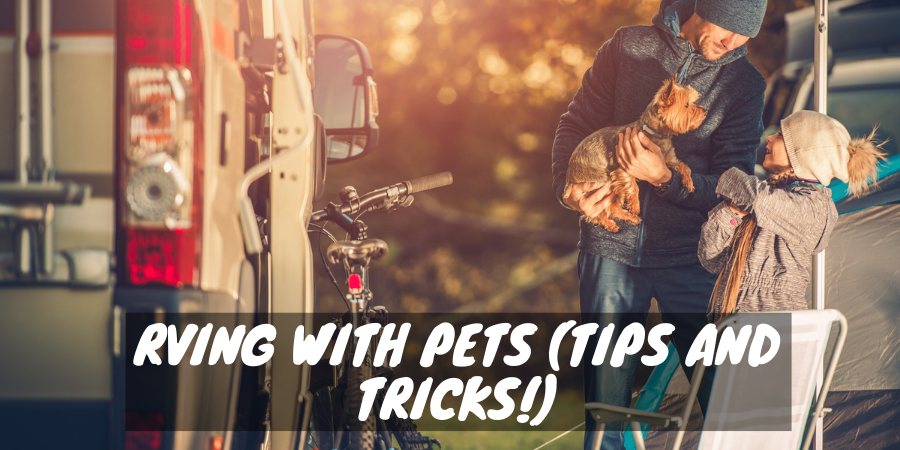Are you planning an RV trip and aren’t sure what clothes to bring?
We all know that space inside recreational vehicles is tight. Knowing which clothes are essential to pack can keep things under control, especially for full-time RVers.
So, what clothing should you bring for spring, summer, fall, and winter camping? Find out down below, where I give you tips on which clothes are best to pack and why.
As a full-time RVer in a small Class C motorhome, I know what clothing items you need, so read on to learn more!
Why You Need to Streamline Clothes for RV Trips
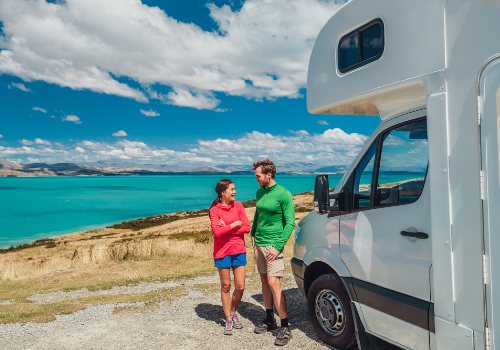
Most RV trips are families or couples, which means more than one person will be fighting over closet or cabinet space inside a camper. Here are the top reasons to plan out a camping wardrobe for different seasons:
RVs Lack Storage for Large Wardrobes
Even big travel trailers, fifth wheels, or Class A motorhomes have limits on clothing space. So bringing along extra clothing “just in case” isn’t practical.
To avoid crammed drawers and closets that increase frustration and stress during camping trips, you need to streamline your wardrobe, so all pieces are functional and mix and match well.
The more people in your RV traveling party, the fewer items each person can bring, so creating a camping capsule wardrobe is essential.
Another aspect of RVs is that most of your clothing items will not be hanging in a closet and instead go into drawers or baskets inside cabinets.
For this reason, you’ll want to select clothing for RV trips that can resist wrinkles, so you aren’t wasting time ironing or walking around looking unkempt.
Doing RV Laundry Is Time-Consuming and Expensive
I’ve learned on my journeys that the more clothes you have in your RV, the more laundry you have.
You could wait to wash clothes until you return home, but having a pile of stinky, dirty clothes inside a camper isn’t pleasant for both odor and taking up space.
Most RVers prefer to avoid a stack of dirty laundry, so getting it washed becomes a priority. Unfortunately, taking clothes to the campground laundry or finding a local laundromat requires paying anywhere from $3-$8 to clean a single load.
Even if you’re lucky to have an RV washer and dryer, you can easily spend a good chunk of your camping time taking care of several loads of laundry.
You can waste time waiting for an available machine at the RV park laundry before you even get to start washing your clothes.
The fewer clothes you bring, the less laundry you’ll have to wash, saving both time and money. With good planning, you can reduce the laundry burden even more by choosing clothing fabrics that resist staining or dry quickly, which I detail below.
Clothes Crammed in RV Closets Get Musty
Most RVers don’t consider that a camper lacks good ventilation, especially inside closets and cabinets.
Cramming clothes into these small spaces will reduce airflow and quickly lead to musty smells.
If you’re camping in humid regions, this problem gets worse and can even lead to mildew growth in only a few days. If you don’t catch mildew growth quickly and wash the item, the tiny black spots can become permanent and ruin the garment.
Less clothing means you can leave ample air space inside cabinets or between hangers, so your clothes remain fresh.
Best RV Clothing Style and Fabric Choices
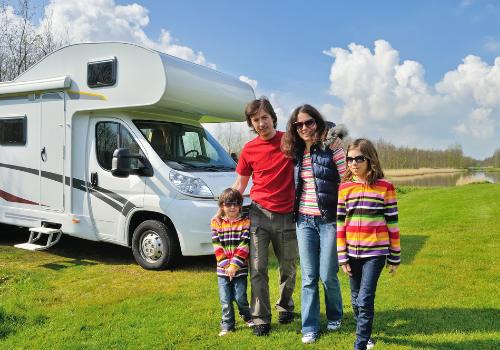
RVing involves many hours on the road and hopefully days of pleasant local exploration, outdoor adventures, and general relaxation. All of these activities require comfortable clothing that won’t wrinkle or stain easily.
You’ll want to look presentable if you decide to pop into a local museum or try out that restaurant with great reviews, without the need to change clothes and create more dirty laundry.
RV Clothing Style Considerations
When selecting clothes to bring on your RV camping trips, think about how appropriate the item is for various activities.
Can you wear it on a hike, but also to a casual eatery? Is the fabric stretchy and soft so that you can wear it all day without uncomfortable tightness around the arms or waistband?
The best style for RV clothing is plain. Solid colors are best, as people are less likely to notice you in the same blue T-shirt versus one with a bold graphic design.
A great pair of tailored joggers in black or navy for both men or women look stylish and can pair with a wide range of tops, yet are supremely more comfortable versus jeans. This pants style is also more lightweight and takes up less room than a typical pair of denim.
Speaking of tailored, packing clothing in your RV that fits correctly goes a long way toward keeping your general appearance neat at all times.
Skip the baggy, oversize sweatshirts and T-shirts that look sloppy and take up more space. Opt instead for clothes that skim the body but aren’t tight.
Thin fabrics allow you to layer up clothing items for more warmth without bulk, yet remove them as the day warms without ruining your overall look.
Lastly, women and girls should give easy-fit dresses a try for many summer camping activities.
Packing and wearing a dress versus a top and pants or shorts requires less storage space and eliminates annoying waistband irritation. You also look instantly put-together and ready for sightseeing, shopping, restaurants, or other events.
Wear a pair of boy-short underwear or bike shorts underneath to avoid the worry of your dress hem lifting.
RV Clothing Fabric Considerations
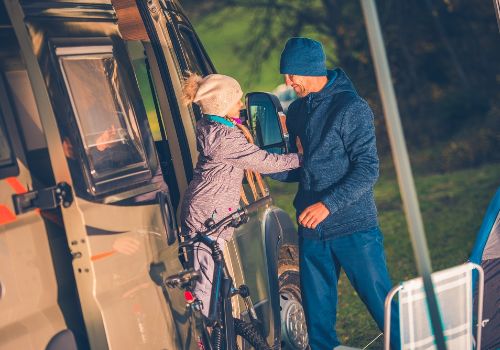
RV camping fabrics must be functional for all types of weather situations.
Ask yourself these questions before selecting what items to pack for your trip: Does it wick away moisture and sweat, so you feel, look, and smell fresh after a day of fun?
Will it provide warmth or buffer you from rain? Is it lightweight and easy to wash without wrinkling when dry?
Here are the best fabrics for RV clothes:
- Bamboo or bamboo blends
- Merino wool
- Polyester or Nylon with Spandex
Bamboo or Bamboo Blend
Bamboo fabric has many attributes similar to Merino wool, such as resistance to wrinkling and germs and the ability to regulate your body temperature, so you feel cooler in summer and warmer in winter.
Bamboo fibers are silkier, so you can select lightweight shirts, pants, skirts, or dresses with a luxurious look and feel that are easy to layer without creating bulk.
Bamboo also provides a natural SPF of 50+, making it the perfect long-sleeve T-shirt for sunny day hikes or boating for people with sensitive skin.
Bamboo is moisture-wicking, but do be aware that this can cause problems if the fabric is too thick, as it can hold the moisture instead of letting it evaporate quickly.
Merino Wool
Merino wool is an ideal fabric for any type of travel because it’s:
- Naturally antimicrobial so it rarely takes on a smell
- Resists dirt and oils allowing a long time between washings
- Very lightweight
- Compacts with little to no wrinkling
- Extremely soft
- Able to regulate body temperature in both hot and cold climates
Merino wool is very finely woven and doesn’t cause that annoying itch other wool fabrics have. The material is pricey but pays for itself over its lifetime.
I slowly built up my RV travel capsule wardrobe to include many Merino wool items by shopping sales at camping retailers like REI or getting lucky at local thrift stores.
I have one short-sleeve T-shirt that you’d swear was cotton as the weave is so fine. I’ve been wearing the shirt about once a week during all seasons of the year for three years running, and it still looks great, so the $80 price tag now seems like a bargain!
Be aware that you’ll want to always air dry Merino wool items by laying them out inside your RV or in the shade outside, to maintain the integrity of the fabric. Luckily, the items dry fast, usually in only a few hours, increasing their usefulness while RVing.
Polyester or Nylon with Spandex/Lycra
Polyester and nylon fabrics have come a long way in both looks and texture. With the addition of stretch fibers such as spandex or lycra, the material blend is another top RV clothing fabric choice for comfort and ease of care.
Most blends will barely wrinkle, dry quickly, and are very lightweight, making wearing, washing, and packing a breeze.
The best place to locate great travel-ready synthetic blend clothing is in department or camping stores’ athletic or outdoor section.
Is Cotton a Good Choice for RV Travel?
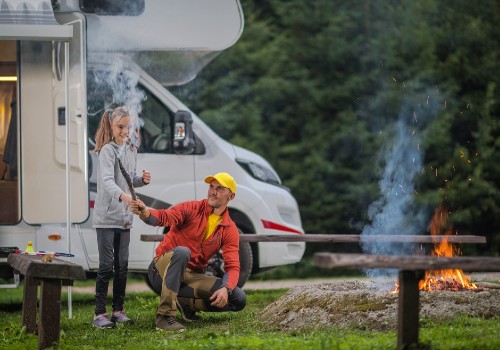
Don’t get me wrong; cotton is a wonderfully soft and comfortable fabric. But, unfortunately, for camping, the material isn’t ideal as it holds sweat and odors, is easy to stain, and wrinkles quickly.
Cotton next to the skin during cold weather activity will still cause you to sweat, then the material has no way to dry underneath a coat or other layers of clothing. The moisture then will get cold, causing your body temperature to drop and make you feel miserable.
The material also stretches out during wear, so it’s hard to wear the garment more than once without looking sloppy and takes longer to dry both in a machine or on a line.
I now have just a couple of cotton items in my RV wardrobe, and those have enough of a stretch blend in them to keep them functional.
I never even look at pure cotton for any of my RV clothing choices when I shop, and that includes underwear!
So unless you have allergies to synthetic fabrics, it’s best to avoid 100% cotton when packing for any season of RV travel.
Best Clothing for Spring, Summer, Fall, and Winter RV Trips
Here are all the essential clothing items you’ll want to have on your packing list for different seasons of the year. Some items are things most people forget or aren’t obvious you’ll need, so take notes!
Many items I select are multi-seasonal, which makes them ideal for full-time RVers or those that love to travel during all seasons.
Do lay out all your items together before packing to see that the colors or patterns allow you to create many different outfits by mixing and matching so you won’t get bored wearing the same thing over and over.
My list is a guideline for one person on a week-long trip. You then have the option to wash and wear the clothes again until your camping trip is over.
Spring RV Wardrobe
Spring camping typically involves 60°F to 70°F daytime temps, with the mornings and evenings much cooler.
Spring requires a mix of clothing items that include:
- 3 short sleeve T-shirts
- 2 long sleeve T-shirts
- 2 pair long pants
- 2 pair shorts
- 1 waterproof, zip-front jacket
- One medium-weight sweater
- 4 pair wool or bamboo fiber socks (thickness/style up to you)
- 7 pair underwear
- Swimsuit
Depending on the region, you may find spring temperatures warmer or colder, so adjust your packing list accordingly. For example, if temps are colder, exchange the shorts for two more pairs of pants, and increase the long-sleeve T-shirts versus short sleeves.
Don’t forget to add a knit hat, gloves, and thin scarf to your kit. All of these items are super lightweight and can condense down into a ziplock bag for storage, but do wonders to give you that extra bit of warmth when you need it.
The waterproof zip-front jacket with a hood is a must-have for any spring camping trip, as rains are common. The jacket will also cut cold winds, so you’ll stay toasty on chilly hikes.
My favorite is the 3L Shell Jacket from Helly-Hansen or the Resolve 2 from North Face for adults and the Pakka from Mountain Warehouse for kids.
A swimsuit is a must-have as many campgrounds have heated pools or hot tubs, or you may be camping at a fun location that has natural hot springs.
Summer RV Wardrobe
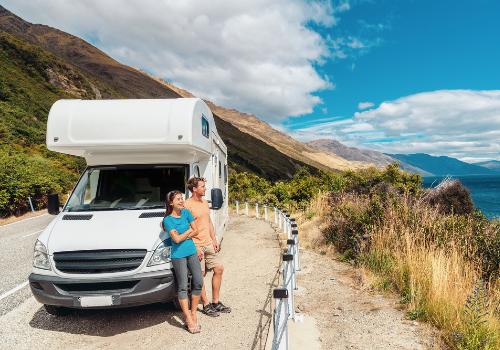
Want to Connect With a Community of Over 1,078 RV Enthusiasts?
Summer camping temperatures typically hit 80°F to 100°F daytime temps, with the nights in the 65°F to 75°F range.
Summer camping allows you to pack the lightest, with the ability to quickly hand wash and line dry clothing on clear days to remove sweat.
Clothing items should include:
- 3 short sleeve T-shirts
- 2-3 tank tops
- 1 collared shirt (especially if you plan to golf)
- 3-4 pair shorts
- 1 rain poncho (or waterproof, zip-front jacket)
- One lightweight jogger pant
- 2-3 pair wool or bamboo fiber socks (thickness/style up to you)
- 7-10 pair underwear
- Swimsuit – plus a coverup for women (optional)
While you’re packing more items for summer, the bulk is less, so you should have a bit of extra room in your RV storage compartments.
I rotate through fewer items, as I have no problem wearing the same things three times a week. However, I find the need to change out of sweaty underwear more often during summer, so pack a few extra pairs.
Many days I wear my swimsuit all the time and forgo an outfit entirely.
I prefer a lightweight rain poncho for summer camping rain showers, as they keep the majority of your body dry, are easy to hang up to dry, and fold right back into their storage pouch. I like the long-lasting quality of the Frogg Togg rain poncho for men, women, and kids.
Autumn RV Wardrobe
Fall camping typically involves 50°F to 75°F daytime temps, with the evenings dropping into the low 40’s, especially as the season progresses toward winter.
With the days getting shorter, the cooler air arrives earlier each evening, so extra warm clothing options are necessary.
Autumn RV packing lists should include:
- 1 short sleeve T-shirt
- 3-4 long sleeve T-shirts
- 3-4 pair long pants
- 1 pair shorts
- 1 lightweight vest
- 1 waterproof, zip-front jacket
- 1-2 medium-weight sweaters
- 5 pair wool socks (thickness/style up to you)
- 7 pair undies
- Swimsuit
Do pack your knit hat, gloves, and scarf for cold days, and if you don’t own one, pick up a polar fleece or nylon/spandex vest. Outdoor Ventures sells a nice array of affordable styles.
A vest is a fantastic layering option over a long-sleeve tee or under your jacket if the weather turns rainy and cold.
TIP: Before you pack, give your footwear a coating of waterproof spray in case you encounter muddy campsites or hiking trails. You can easily rinse the mud off sneakers or boots without soaking the material.
Winter RV Wardrobe
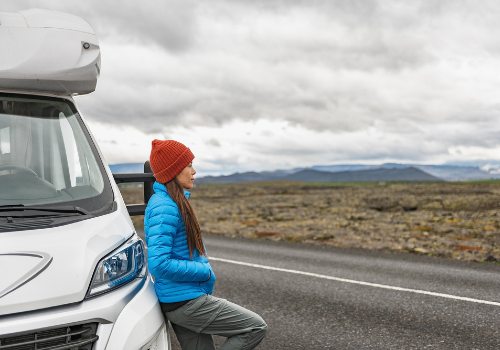
Winter camping typically involves 30°F to 50°F daytime temps, with the mornings and evenings dropping near freezing or below.
Winter requires more layers of clothing that include:
- 5-6 long sleeve T-shirts
- 4-5 pair long pants
- 1 pair silk long underwear
- 1 waterproof, winter coat
- 1 medium-weight sweater
- 1 heavy-weight sweater
- 4 pair wool socks (thickness/style up to you)
- Thicker and warmer hat, gloves, and scarf set
- 7 pair undies
- Swimsuit
Winter means frigid weather for many regions of the country, so packing enough options so you can layer up allows you to enjoy outdoor winter camping fun.
I find the key to warmth is to start your layering with a set of silk blend long underwear, that can also double as your nightclothes. The fabric is super thin, so you don’t feel uncomfortable, but the silk fibers retain heat wonderfully yet allow your skin to breathe.
Don’t forget that swimsuit, as you never know what campground has a hot tub you may want to enjoy!
The Best RVing Footwear
Shoes take up plenty of space, so keeping your selection to three pairs maximum should always be your goal.
Most RVers bring along:
- Sandals (aim for a pair that can double as a water shoe)
- Sneakers
- Hiking boots
If hiking isn’t your style, you can add a dressier version of the shoe for nicer outfits, such as a loafer for men or a slip-on flat or heel for women.
You can also choose a more rugged style of sneaker, known as a “hiking shoe,” that can give you traction and comfort for the occasional trail walks and is fashionable enough for daily wear. CC-Los has a great selection at reasonable prices.
Flip-flops are a typical “must-have” for RVers to pack, but they aren’t very practical unless you invest in a pair with excellent traction and a cushioned sole that can be worn in the campground shower or for long walks about town while sightseeing.
Don’t bother with a cheap pair that will slip on wet pool or bathroom surfaces and always blow out at the most inconvenient time. Instead, invest in a pair like the Olukai Ohana flip flops that come in men’s and women’s sizes and styles but are super high-quality and can be worn around water safely.
When it comes to socks, I firmly believe going with a pure Merino wool fiber is the best option for both comfort and durability. You can find thin or thick versions that work well for sneakers or hiking boots from Amazon or other outdoor and camping supply stores.
Wool socks reduce blister formation, will keep your feet warm even when wet, and keep foot odors to a minimum, all great traits for RV camping enthusiasts.
Final Thoughts
Packing for an RV trip in any season takes thoughtful planning, which helps you avoid taking too many clothes that only end up getting in the way whether you wear them or not.
Follow the lists and tips above to streamline your RV clothing and build a capsule camping wardrobe of the best quality materials that stand the test of time.
With the right RV clothes, you’ll always have what you need to stay cool or warm while looking neat and stylish no matter where you roam!
Packing Clothes for Full Time-Life on the Road (Video)
"Man cannot discover new oceans unless he has the courage to lose sight of the shore."
-- Andre Gide

